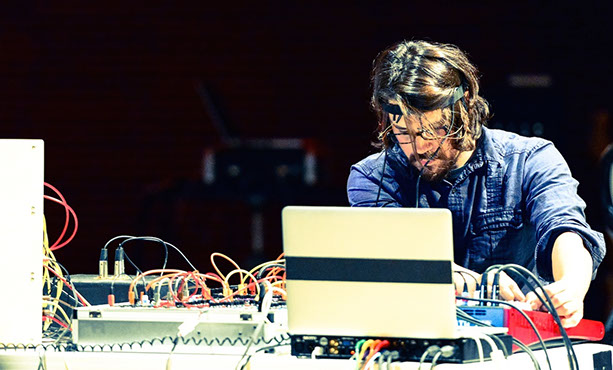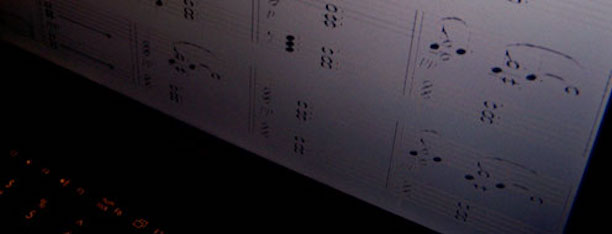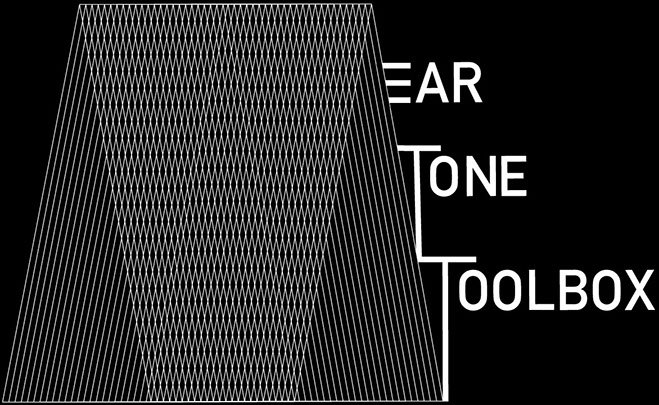Alex Chechile
Adjust volume until the described effect is detected.
Headphones are discouraged for the phenomenon works best in an acoustic space.
On the Sensations of Tone (2010 - present)
On the Sensations of Tone is a series of pieces that explore the physicality of sound and spatial depth through the application of research in psychoacoustics and the biomechanics of hearing. The performances and installations create a unique layer of spatial depth by provoking the ears to generate sounds of their own.
Difference tones are sounds produced by auditory hair cells in response to specific acoustic frequency combinations. Absent from the physical space, the “ear tones” are perceived as localized inside the head. Once elicited, the phenomenon produces an expanded sonic depth of field between the external sounds in the room and the internal sounds generated in the ear.
On the Sensations of Tone VIII evokes ear tones by acoustic and electronic means. During the development of the piece, a spectral analysis of the crotales revealed single notes that contained frequencies in the proper amplitude and ratio for eliciting difference tones. In performance, the crotales are amplified and mixed with electronic tones to create a dense difference tone spectrum. Using multichannel speakers, the physical space is transformed into an immersive environment where audience movement causes difference tones to appear, disappear, and change character. Microscopic and macroscopic listening is possible by shifting attention between the acoustic tones, the ear tones, and all audible sound. The effect can be enhanced by cupping hands around one’s ears. Because difference tones can produce a mild tickling sensation in the ear, the pieces in On the Sensations of Tone demonstrate the physicality of sound through tangibility of natural biomechanical processes, and the works educe concepts of outer and inner perception.
On the Sensations of Tone VIII was performed by Loren Mach (percussion) and Alex Chechile (electronics) on May 27, 2015 at the Bing Concert Hall, Stanford, CA, and the video was subsequently presented at venues/events including IRCAM in Paris, and CICTEM 2015 in Buenos Aires. The 24.7 channel audio was remastered for stereo presentation in the video.
For more information, see Chechile’s PhD dissertation here.

Music Re-Informed by the Brain (2006- present)
The body and the brain produce measurable information during the act of musical creation.
This information is one part of a significantly connected recursive relationship between the musician and the music.
Music Re-Informed by the Brain is a collection of projects that use physiological information acquired during music performance to shape the overall musical experience. By doing so, musical decisions become more intimately linked to the performer, allowing for one's unconscious involvement to play a direct role in how the piece is sounded. This musical biofeedback loop allows an additional layer of spontaneity between performers, the audience, and/or the composer.
Composition System
"The importance of a performer to a composer is just something one sees on a dedication page, and unless one is a musicologist or you really get into it, you just don't know the involvement, to what degrees a performer could influence the kind of music the composer might play."
-Morton Feldman, 1982
In the composition system, the roles of the performer and the composer are fused though a dynamic score that contains both prewritten sections, and sections that are generated in real-time by the performer's cognitive response to the work.
Through the live analysis of the performer's cognitive reaction to the piece, the presence of particular brainwaves is mapped to a music theory that creates new written music based on musically similar associations that the brainwaves possess.
Improvisation System
"At the actual time of performance, the musician does not calculate the procedures that will guide his playing. Rather he plays from a level of consciousness somewhat removed from the purely rational... [performing] intuitively, wherein the dictates of traditional procedures are integrated with his immediate mood and emotional needs."
-Derek Bailey, 1992
Picking up where Derek Bailey's words leave off, the improvisation system uses real-time EEG brainwave sampling to create music that is closely linked to one's musical intuition.
Depending on the level of involvement, the performer's outgoing sound is manipulated in a variety of ways, such as control voltage for a modular synthesizer, and location, speed and direction of the sound in a multi-channel speaker configuration.
At the heart of the system lies an interface for implicitly controlling sound by the shared experience of musical communication.

photo: Ge Wang
Binaural recording of a four channel live performance using the EEG improvisation system. Headphones required. Recording by Delf Maria Hohmann.
Data Decay (2011)
Revisiting an early computer data storage format that uses reel-to-reel audiotape, Data Decay is an installation that uses computer data as the primary sound material and room acoustics as a modifying agent.
A series of images is converted into sound and played back in a tape loop. The looping audio is decrypted, and the resulting visual content is projected. Room acoustics and mechanical inconsistencies of the tape deck affect the visualization of the projected image.
This project was comissioned by Harvestworks with funds from the New York State Council on the Arts.
The Experimental Television Center’s Finishing Funds program is supported by the Electronic Media and Film Program at the New York State Council on the Arts.
Geography (2009)
Sound: Alex Chechile
Image: Cathleen Grado
Geography addresses the impermanence of memory and the manner in which space and location affect sensory development. It is the first of an ongoing series of works between the artists.

The Ear Tone Toolbox is a free collection of instruments that evoke naturally generated tones in the ear. Called difference tones or auditory distortion products, the “ear tones” occur at separate frequencies from the provoking acoustic tones, sound as if they emerge from within the head, and are not physically present in the acoustic space. The instruments in The Ear Tone Toolbox produce the necessary acoustic frequencies for evoking difference tones with precision. The instruments control the two most prominent difference tones: the quadratic difference tone and the cubic difference tone.
The Ear Tone Toolbox contains instruments that are ready to use in a variety of software and hardware environments, as well as optional source code for compiling to other formats and platforms using the Faust programming language. The current version of the software consists of several instruments, each with multiple variations. The instruments can be used in most digital audio workstation (DAW) software such as Ableton Live, programming environments such as Max/MSP or Pure Data, or with hardware modular synthesis systems using the OWL module.
For more information, see Chechile’s PhD dissertation here.
On the Sensations of Tone
Music Re-Informed by the Brain
Data Decay
Geography
The Ear Tone Toolbox